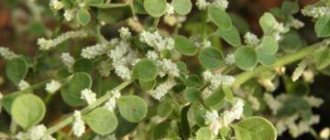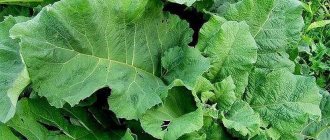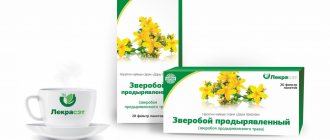Great plantain: description, application, photographs
Large plantain (Plantago major L.) belongs to the Plantain family (Plantaginaceae). Other names of the plant: porannik, proreznik, boil grass.
The generic name of the plant comes from the Latin words: planta - foot, sole and agere - to lead, to follow. This name is given because plantain seeds have mucous cells and, swelling after rain or dew, become sticky, stick to the sole of shoes and are spread by people, which is why plantain grows along the edges of roads and paths, which is where the Russian name comes from. The species definition translated from Latin means “large”, since the leaves of this type of plantain are larger than those of others.
The plantain is big. Photo: Tatiana Polteva.
Botanical description. Great plantain is a perennial herbaceous plant with a vertical, short, thin rhizome, from which thin thread-like adventitious roots extend. The leaves are large, petiolate and collected in a basal rosette. They are broadly ovate or broadly elliptical, entire-margined with 3–9 arched main veins. One or several flower arrows 10–45 cm high emerge from the basal rosette. The flower arrows are rounded, ending in a long, thick, cylindrical spike-shaped inflorescence. The flowers are small, inconspicuous, brownish, filmy. During flowering, stamens with dark purple anthers protrude far from them. Blooms from May–June until autumn. The fruits ripen from June–July until autumn. The fruits are multi-seeded, ovoid capsules. Propagated by seeds.
It grows near roads and on paths, near housing, in meadows and pastures, in crops, and in vegetable gardens. Found on forest edges and clearings. Distributed mainly in the South-Western and Northern Altai in the forest-steppe and forest zones, rising up to the alpine belt. In addition to the great plantain, the Altai also contains middle plantain (Plantago media L.) and the lanceolata L..
Chemical composition. Great plantain leaves contain the glycoside aucubin, bitter and tannin substances, mucus, caffeic, coumaric, citric and oleanolic acids; flavonoids, ascorbic acid, carotene, choline, adenine, enzymes, saponins, pectin substances, etc. The seeds of the plant contain mucilaginous substances, fatty oils, steroid saponins, aucubin and oleanolic acid.
Large plantain, blooming. Photo: Tatiana Polteva.
Great plantain is a medicinal plant. The healing properties of this plant were known in Chinese medicine more than 3 thousand years ago. The Greek scientist Dioscorides spoke about the benefits of plantain. It was the most common medicinal plant among medieval doctors.
The biologically active substances of plantain promote the regeneration of damaged tissues, enhance the secretory function of the stomach, have a calming effect, lower blood pressure, and have a beneficial effect in the treatment of acute and chronic colitis. Fresh leaves and juice of plantain have a hemostatic effect.
In medicine, preparations from plantain leaves are used in the treatment of diseases of the gastrointestinal tract (gastritis with normal and low acidity, acute and chronic colitis, enteritis, enterocolitis, stomach and duodenal ulcers), inflammatory processes in the liver and gall bladder, and also as an expectorant a remedy for bronchitis, whooping cough, pulmonary tuberculosis and other diseases of the respiratory organs, accompanied by the release of thick secretions. Plantain preparations are contraindicated for hyperacid gastritis and peptic ulcers with high acidity.
Freshly crushed or dry (pre-soaked in water) leaves are applied to the affected surface for infected wounds, ulcers, burns, cuts, bruises, abscesses, boils, skin inflammation, weeping eczema. For the same purpose, you can use an ointment made from plantain leaves with Vaseline or peach oil. An aqueous infusion of seeds is used as an enveloping and mild laxative for chronic constipation, enterocolitis, and colitis.
In folk medicine, a water infusion and decoction of the leaves are used for coughs, bronchitis, asthma, pulmonary tuberculosis, pleurisy, stomach ulcers, inflammation of the gallbladder, kidney and urinary tract diseases. It is used externally among the population as a wound healing agent for chronic ulcers, burns, bruises, cuts and various skin diseases. Fresh crushed leaves are a well-known wound healing agent that relieves pain from stings of bees, bumblebees, and wasps. Juice and water infusion are recommended as an effective remedy for various skin rashes.
Collection and drying. Plantain leaves are collected with a small remainder of the petiole during the flowering period, tearing them off by hand. Plantains that grow near busy highways should not be collected. Leaves are dried in attics, in the open air in the shade of buildings, in sheds or in dryers at a temperature of 40–50 ° C. After drying, the raw materials are sorted, removing yellowed and browned leaves, flower shoots and accidental impurities of other plants.
The plantain is large and young. Photo: Tatiana Polteva.
Great plantain is also used as a food plant. Young leaves are eaten in salads with onions, horseradish, potatoes, and nettles. It is used in omelettes and casseroles, in cereals and drinks, mashed potatoes and cutlets, in cabbage soup and other dishes. Plantain can be widely used in dietary nutrition, since the plant is rich in chemical composition and has a healing effect on the body. Young, recently blossomed leaves are collected for food purposes.
List of references and sources: 1. Krylov G.V., Kozakova N.F., Camp A.A. Plants of health. – Novosibirsk: Novosibirsk Book Publishing House, 1989. – P. 149–150. 2. Sviridonov G. Useful plants of the Altai Mountains. – Gorno-Altai branch of the Altai Book Publishing House, 1978. – P. 93–94. 3. Popov V.I., Shapiro D.K., Danusevich I.K. Medicinal plants: Collection, preparation, use. – Minsk: “Polymya”, 1984. – P. 163–165. 4. Sviridonov G.M. Gifts of nature on your table. – Kemerovo book publishing house, 1984. – P. 36. 5. Shimin E.N. Medicines in the garden: A gardener's guide. – Kalinin: Kalininskaya Pravda, 1990. – P. 109–110.
Material prepared by V.B. Poltev, January 28, 2022.
Collection, preparation and drying of plantain
The leaves of the great plantain (Folium Plantaginis majoris) are mainly used for medicinal purposes. Raw materials are harvested in the flowering phase in May - August before the leaves begin to yellow or partially redden. In years with humid, warm summers, several collections can be made in the same areas as the leaves grow. In hayfields, secondary collection of raw materials is possible in August - September. When harvesting, the leaves are cut off with a knife or sickle, with small remains of petioles; in denser thickets they are mowed down and plantain leaves are selected from the mowed mass.
With proper preparation, the same arrays can be used for several years, since plants usually die off in the 3-4th year of life. Harvesting leaves contaminated and affected by pests and diseases, especially powdery mildew, is not allowed. You cannot cut off the entire rosette; this will lead to rapid destruction of the thickets. It is recommended to collect leaves after rain, when they are dry. When procuring raw materials, it is necessary to leave some well-developed specimens for reproduction. Dry in air in the shade or in dryers at a temperature of 40-50 °C. The shelf life of leaves and grass is 2 years. The smell of the raw materials is weak, the taste is slightly bitter.
Seeds are harvested with peduncles in their mature state. The shelf life of the seeds is 3 years.
Notes
- For the convention of indicating the class of dicotyledons as a superior taxon for the group of plants described in this article, see the section “APG Systems” of the article “Dicotyledons”.
- ↑ 1 2 3 4 Blinova K.F. et al.
[herba.msu.ru/shipunov/school/books/botaniko-farmakognost_slovar1990.djvu Botanical-pharmacognostic dictionary: Reference. allowance] / Ed. K. F. Blinova, G. P. Yakovleva. - M.: Higher. school, 1990. - P. 225. - ISBN 5-06-000085-0.
Growing and cultivating plantain
Plantain prefers well-fertilized, chernozem, sandy loam or loamy soils. The best predecessors are legumes and row crops. The area intended for sowing is dug up to a depth of 25-30 cm and 2-4 kg of manure, 4.5-6 g of phosphorus and 3 g of potassium and nitrogen per 1 m are added. Before winter, seeds are sown superficially, without planting, sprinkled with humus in a layer of 1-1.5 cm. In spring, with the beginning of sowing early grain crops, to a depth of 1-2 cm, with row spacing of 25-30 cm. To speed up the emergence of seedlings, the seeds are stratified. To do this, they are mixed with sand (1:4) and kept for two days at a temperature of 18-20 ° C, after which they are transferred to the cellar or buried in the snow for 1-2 months. Caring for crops consists of loosening the soil and weeding. Plantain leaves are collected 1-2 times per season. The first cleaning is carried out at the beginning of flowering; the second - after 2 months.
Literature
- Gubanov, I. A. et al.
1201.
Plantago major
L. sl (incl.
P. intermedia
DC., P.
major
L. subsp.
intermedia
(DC.) Arcang.) - Great plantain // [herba.msu. ru/shipunov/school/books/gubanov2004_illustr_opred_rast_sred_rossii_3.djvu Illustrated guide to plants of Central Russia. In 3 t]. — M.: Scientific T. ed. KMK, Institute of Technology. research, 2004. - T. 3. Angiosperms (dicotyledonous: dicotyledonous). - P. 240. - ISBN 5-87317-163-7.
Medicinal properties of plantain
During the pharmacological study of herbal preparations from the leaves of the great plantain, their wide biological activity was established. Juice (from fresh leaves) of plantain is effective in treating corneal wounds; suppresses the growth of pathogenic staphylococcus in a dilution of 1:2, Pseudomonas aeruginosa in a dilution of 1:4 and inhibits the growth of hemolytic streptococcus in a dilution of 1:2.
The extract from the leaves has a sedative and hypotensive effect. Aqueous infusions from plantain leaves enhance the activity of the cilia of the ciliated epithelium of the respiratory tract, which leads to increased secretion of bronchial mucus, as a result of which the sputum thins and makes it easier to release when coughing. Extract from plantain leaves has a hemostatic, wound-healing and bacteriostatic effect in the treatment of wounds.
Plantain has some calming effects and lowers blood pressure.
An excerpt characterizing the Great Plantain
- You're lying! - I saw it myself. - How? Have you seen Mack alive? with arms, with legs? - Hike! Hike! Give him a bottle for such news. How did you get here? “They sent me back to the regiment again, for the devil’s sake, for Mack.” The Austrian general complained. I congratulated him on Mak’s arrival... Are you from the bathhouse, Rostov? - Here, brother, we have such a mess for the second day. The regimental adjutant came in and confirmed the news brought by Zherkov. We were ordered to perform tomorrow. - Let's go, gentlemen! - Well, thank God, we stayed too long. Kutuzov retreated to Vienna, destroying behind him bridges on the rivers Inn (in Braunau) and Traun (in Linz). On October 23, Russian troops crossed the Enns River. Russian convoys, artillery and columns of troops in the middle of the day stretched through the city of Enns, on this side and on the other side of the bridge. The day was warm, autumn and rainy. The vast perspective that opened up from the elevation where the Russian batteries stood protecting the bridge was suddenly covered with a muslin curtain of slanting rain, then suddenly expanded, and in the light of the sun objects as if covered with varnish became visible far away and clearly. A town could be seen underfoot with its white houses and red roofs, a cathedral and a bridge, on both sides of which masses of Russian troops poured, crowding. At the bend of the Danube one could see ships, an island, and a castle with a park, surrounded by the waters of the Ensa confluence with the Danube; one could see the left rocky bank of the Danube covered with pine forests with the mysterious distance of green peaks and blue gorges. The towers of the monastery were visible, protruding from behind a pine forest that seemed untouched; far ahead on the mountain, on the other side of Ens, enemy patrols could be seen. Between the guns, at a height, the chief of the rearguard, a general, and a retinue officer stood in front, examining the terrain through a telescope. Somewhat behind, Nesvitsky, sent from the commander-in-chief to the rearguard, sat on the trunk of a gun. The Cossack accompanying Nesvitsky handed over a handbag and a flask, and Nesvitsky treated the officers to pies and real doppelkümel. The officers joyfully surrounded him, some on their knees, some sitting cross-legged on the wet grass. - Yes, this Austrian prince was not a fool to build a castle here. Nice place. Why don't you eat, gentlemen? - Nesvitsky said. “I humbly thank you, prince,” answered one of the officers, enjoying talking with such an important staff official. - Beautiful place. We walked past the park itself, saw two deer, and what a wonderful house! “Look, prince,” said the other, who really wanted to take another pie, but was ashamed, and who therefore pretended that he was looking around the area, “look, our infantry have already climbed there.” Over there, in the meadow outside the village, three people are dragging something. “They will break through this palace,” he said with visible approval. “Both,” said Nesvitsky. “No, but what I would like,” he added, chewing the pie in his beautiful, moist mouth, “is to climb up there.” He pointed to a monastery with towers visible on the mountain. He smiled, his eyes narrowed and lit up. - But that would be good, gentlemen! The officers laughed. - At least scare these nuns. Italians, they say, are young. Really, I would give five years of my life! “They’re bored,” said the bolder officer, laughing. Meanwhile, the retinue officer standing in front was pointing something out to the general; the general looked through the telescope. “Well, so it is, so it is,” the general said angrily, lowering the receiver from his eyes and shrugging his shoulders, “and so it is, they will attack the crossing.” And why are they hanging around there? On the other side, the enemy and his battery were visible to the naked eye, from which milky white smoke appeared. Following the smoke, a distant shot was heard, and it was clear how our troops hurried to the crossing. Nesvitsky, puffing, stood up and, smiling, approached the general. - Would your Excellency like to have a snack? - he said. “It’s not good,” said the general, without answering him, “our people hesitated.” – Shouldn’t we go, Your Excellency? – said Nesvitsky. “Yes, please go,” said the general, repeating what had already been ordered in detail, “and tell the hussars to be the last to cross and light the bridge, as I ordered, and also to inspect the flammable materials on the bridge.” “Very good,” answered Nesvitsky. He called to the Cossack with the horse, ordered him to remove his purse and flask, and easily threw his heavy body onto the saddle. “Really, I’ll go see the nuns,” he said to the officers, who looked at him with a smile, and drove along the winding path down the mountain. - Come on, where will it go, captain, stop it! - said the general, turning to the artilleryman. - Have fun with boredom.
Chemical composition of plantain
Fresh plantain leaves contain 20% nitrogenous and 10% nitrogen-free extractives, 10% fiber, 0.5% fat, glycoside aucubin, which is broken down during hydrolysis into aucubigenin and glucose, flavonoids, carbohydrate mannitol, vitamin K, ascorbic acid (289 mg% ), citric and oleic acids, tannins, bitterness, traces of alkaloids. The seeds contain up to 44% mucilage, about 20% fatty oil and 0.16-0.17% plantose, 22% protein, 16% amino acids, steroid saponins.
The leaves contain: ash - 15.79%; macroelements (mg/g): K - 44.60, Ca - 39.30, Mn - 3.60, Fe - 0.70; microelements (CBN): Mg - 0.25, Cu - 0.92, 2n - 0.70, Co - 0.25, Mo - 2.67, Cr - 0.12, Ba - 22.05, V - 0 .13, Se - 0.70, Ni - 0.17, Sr - 1.82, Pb - 0.13. B - 45.60 µg/g. Cd, Li, Au, Ag, I, Br were not detected. Concentrates Cu, Fe, Zn, Mo, Ba, Sr, especially Ba. Can accumulate Cu, Cr.








